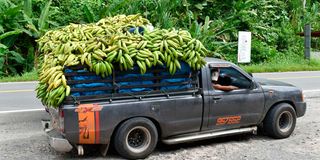Premium
How to remove the stubborn windscreen smear

What is the best solvent to remove stubborn windscreen stickers?
What is the best solvent to remove stubborn windscreen stickers without scratching the glass, or to get rid of the dry glue residue that some of them leave behind?
--Peter K.
I use regular fly/mosquito spray (for example Doom). It seems to work as well as anything else I’ve tried, and it is readily available. It quickly dissolves sticker adhesives that have gone hard so they can be wiped away with a tissue or soft cloth, followed by a normal wash-and-rinse with soap and water.
If a sticker that won’t budge is absorbent, soak it with fly spray, wait a few minutes, and it will usually respond to a light scrape with a fingernail or “edge” made of something too soft to scratch the glass. If the old sticker is made of plastic, you might need to sufficiently “spoil” its outer surface with sandpaper so the fly spray can reach the adhesive layer.
***
Helping your pick-up cope with heavy loads
My workhorse is a one-tonne pick-up, which I use moderately most of the time. But there are occasions when I need to carry a really heavy load. When that happens, what are the mechanical dangers and is there anything I should do to reduce the risk of damage? What are the factors that determine the official load rating of a vehicle, and are there any simple and inexpensive ways to increase it?
--HM.

There are occasions when I need to carry a really heavy load in my pickup.
The front-line issue is tyre pressure. These should be adjusted for any heavy load, even for weights that are within the design capacity of the vehicle. If the recommended “unladen” tyre pressure is, say, 30 psi, pressures should be increased by about 10 percent for a moderate load and another 10 percent if fully laden. Use the shape of the tyre walls as your guide. They should remain constant.
If tyre pressures have to be increased by 30 percent or more to retain the same tyre wall shape, you are probably “over” loaded to a level that might compromise control of the vehicle and impose possibly damaging strain on some components - especially the suspension and its mountings, and also the drive train. The degree of risk depends on the road surface, the speed and the distance involved.
The official load rating of a vehicle does, of course, leave some margin for tolerance or error. That safety leeway will vary by make and model, but there is reason to think that it might be quite small on Kenya’s “one-tonners”. That’s the name we use here, and the logbooks say 1,000 kgs, but in many other markets essentially identical vehicles are rated at 500 kgs. Local importers may opt for what the manufacturer calls a “heavy duty” variant (with beefed up leaf springs and shock-absorbers, and perhaps reinforced mountings) but in global manufacturing terms “heavy duty” is usually a fractional increase, rarely of more than 20 percent. It is a durability margin for hard use and does not change the fundamental load rating.
Significantly and permanently increasing that maximum weight for regular and extended transport of well over 1,000 kgs means changing so many components that it is probably simpler to change the vehicle and get a model purpose-built for the bigger task.
Certainly, you can modify a one-tonner to some degree. Fit stiffer springs or an additional “helper” leaf. But then you need to balance that with stiffer dampers and reinforce the mountings, fit stouter and stronger rubber bushes, and perhaps flitch (reinforce) the chassis at the mounting points. Depending on what the heavy load is made of, you might have to reinforce the load bed plate, and all its body mountings, and fit tyres with a higher ply rating. So then you must consider the design strength of the wheel bearings.
Next, is the engine powerful enough to pull the additional weight without undue strain, and are the gear ratios designed for one ton still right for nearly twice that load (plus the extra weight of the modifications) or will the gaps force you to scream the engine in one gear and then labour in the next? And are the shafts and cogs in the gearbox and differential, and the clutch, robust enough to take double the strain and dynamic shocks they were designed for? And once you have got the vehicle moving correctly, will the original brakes be able to stop the considerable increase in momentum? All of these issues and parts are assessed (individually and collectively) in the original design to arrive at a target load rating. If you significantly change one part, you have to consider them all.
Well short of those extremes, there are of course many one-tonner owners who use their vehicles for normal loads but occasionally need to carry something especially heavy – as a one-off. Within reason, this can be done on the standard vehicle – very carefully and over a short distance – without causing damage. Carefully means:
1. Pump up the tyres as already noted.
2. Before you load, get down and dirty to measure the space between the rear bump stops and the rear axle/springs/suspension arms.
3. To the extent possible, put the load as far forward on the loadbed as manageable, with as little weight as possible on the overhang behind the back wheels (this will spread the load more equally between the back and front tyres/suspension.
4. Once loaded, check the bump stop gap again. There must be at least some remaining space. If the bump stop is already hard-pressed against the spring, abandon the project (or reduce the load). If the bump gap is very small or the bump stop is only just touching and not already squashed, the surface of your journey must be almost completely smooth and your speed limit should be walking pace – or less. The load may need to be secured to stop it from sliding backwards.
5. The supposition is that this challenge is considered only on farm tracks, around building sites, or on quiet suburban streets – not on major highways.
6. The stress on the engine and drive train as the vehicle starts to move could be considerable, so release the clutch very gradually to avoid any dynamic shock as the gears and diff engage and take up the strain. The diff is likely to be most vulnerable. If your pick-up has 4WD, engage that (in low range if available) so all four wheels and both diffs are sharing the torque load.
7. If you are going to make several “overload” trips (for example carrying a 1,500 kilo water tank or equivalent loads of stones/sand/rubble/earthworks/steel rods from one part of a site to another) even over a relatively short distance it might be more economical (in time and risk as well as cost) to hire a bigger truck! It could turn ten trips into just one or two. The “saving” of doing it yourself could be a false economy.
This clinic will not tire of saying that the best reliability, durability and economy will be achieved when a vehicle is used for and within its design purpose and is diligently maintained. That does not disqualify some extreme one-off tasks, but that capacity should be used – carefully - in emergencies, not as a routine.





